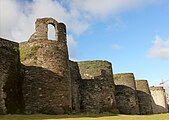Roman walls of Lugo
| UNESCO World Heritage Site | |
|---|---|
 | |
| Location | Lugo, Galicia, Spain |
| Criteria | Cultural: (iv) |
| Reference | 987 |
| Inscription | 2000 (24th Session) |
| Area | 1.68 ha (4.2 acres) |
| Buffer zone | 59.88 ha (148.0 acres) |
| Coordinates | 43°00′40″N 7°33′12″WCoordinates: 43°00′40″N 7°33′12″W |
The Roman walls of Lugo (Spanish, Galician: Muralla Romana de Lugo) were constructed in the 3rd century and are still largely intact, stretching over 2 kilometers around the historic centre of Lugo in Galicia (Spain). The fortifications were added to UNESCO's World Heritage List in late 2000 and are a popular tourist attraction.
Contents
Description
Walls
The city walls were built between 263 and 276 A.D. to defend the Roman town of Lucus Augusti (present-day Lugo) against local tribesmen and Germanic invaders. The walls formed part of a complex of fortifications which also included a moat and an intervallum (the clearing between the walls and the city). The entire length of the walls is around 2,120 metres (6,960 ft), enclosing an area of 34.4 hectares. Not all of the town was enclosed by walls: much of the southeastern part of the town remained unprotected, while in other places unused areas were enclosed by walls.[1][2]
The width of the walls is around 4.2 metres (14 ft) and their height varies between 8 metres (26 ft) and 12 metres (39 ft). The walls consist of internal and external stone facing with a core of earth mixed with gravel, pebbles and worked Roman stone recycled from demolished buildings, cemented with water.[1][2]
Gates
There are ten gates in the walls: five dating to Roman times; and five added after 1853 to accommodate the expanding town population. The best preserved original gates are the Porta Falsa and the Porta Miña, the latter still has its original vaulted arch set between two towers. Five stairways and a ramp provide access to the parapet walk over the walls. Within the walls, a number of double staircases provide access to the towers from the parapet walk.[1][2]
Towers
Of the original towers, 49 are still intact, and another 39 have partially survived. The towers were built at irregular intervals along the walls. They consist of two storeys and are mostly semicircular; a few are rectangular. The spaces between the towers varies from 5.4 metres (18 ft) to 12.8 metres (42 ft). A mix of materials was used for the construction of the towers. Often the base of the tower was constructed of dressed granite, with the remainder in slate.[1]
History
Pilgrim route
During the Middle Ages, pilgrims passed through the gates of the Lugo walls, particularly Porta Miña, on their way to Santiago de Compostela.[2]
Present day
The fortifications were added to UNESCO's World Heritage List in late 2000 as "the finest example of late Roman fortifications in western Europe." [1] The walls have held Spanish monument status (Bien de Interés Cultural) since 1921.[3] In 2007 the walls were twinned with the Great Wall of China during a ceremony attended by China's then-ambassador to Spain, Qiu Xiaoqi.[4]
A walkway over the walls now allows visitors to stroll along the entire length. The town also has a visitor's centre dedicated to the walls, the Centro de Interpretación de la Muralla. Since the inscription of the walls on the World Heritage List in 2000, Lugo holds a popular festival called Arde Lucus each year to celebrate its Roman past.[5][6]
Gallery
See also
| Wikimedia Commons has media related to Ancient Roman walls of Lugo. |
References
- ^ a b c d e "Roman walls of Lugo", UNESCO World Heritage Centre
- ^ a b c d "Lugo City Walls in Lugo, Spain", Spain.info
- ^ "Muralla Romana de Lugo", Comunidad Autónoma de Galicia (Spanish)
- ^ "China y Lugo hermanan sus murallas", La Voz de Galicia, 7 February 2007 (Spanish)
- ^ "Archived copy". Archived from the original on 2011-10-05. Retrieved 2010-07-19.
- ^ Acaba un Arde Lucus no que máis de 460.000 persoas botáronse á rúa en tres días Archived July 1, 2010, at the Wayback Machine, nova en El Progreso o 27 de xuño de 2010.
'로마공화정-로마제국' 카테고리의 다른 글
| <펌> Fall of the Western Roman Empire (0) | 2019.11.26 |
|---|---|
| <펌> Sack of Rome (410) (0) | 2019.11.26 |
| <펌> Theodosius the Great (347-395, 재위 379-395) (0) | 2019.11.08 |
| <펌> 로마-파르티아 전쟁 (BC 66 - AD 217) - 위키백과 (0) | 2019.05.24 |
| <펌> Publius Quinctilius Varus (바루스) (BC 46 - AD 9)-위키 (0) | 2019.02.24 |





